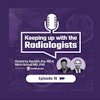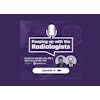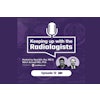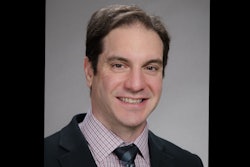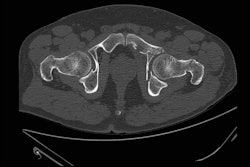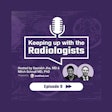Nick Bryan, MD, PhD, neuroradiologist and former chair of radiology at University of Pennsylvania Health Systems, remembers 20% cuts and a two-year department lockdown in Episode 15 of AuntMinnie's Keeping Up with the Radiologists podcast.
Getting through that unusual era of "financial disaster" meant major changes. People were uncomfortable, Bryan recalls. With host Saurabh (Harry) Jha, MD, Bryan walks through the first moments of uncertainty around the year 2000 as then-Penn President Judy Rodin enacted change that would take Bryan and his colleagues into the creation of Penn Medicine.
"Almost no one left," Bryan said, explaining how a buyer for the system had been identified -- and they'd named their price, around $1 billion. "What we were going through here wasn't terribly unique. ... It was not a fun two years, I can assure you, and people in the department will remember this."
They could buy no equipment. They could borrow no money. They needed to cut expenses and staff by 20% -- a la DOGE today. What happened was a transient failure of change management, according to Bryan.
However, within two years, Penn started to make money, and Bryan said he saw that the model that had been established was "rock solid -- one corporation, everybody worked for Penn, no ifs, ands, or buts. After that, the model proved to be highly successful." He added, "It was a tough decision not to sell the health system."
Career built on change
Beyond the seismic shift into the new era of Penn Medicine, the stories in this episode can be divided into five segments. Each characterizes a type of categorical change that Bryan observed and worked through during his 50 years of practice.
A fellow radiologist fought for what would become an obsolete medical imaging technique. What was the technique, and why was it so bad for people?
"This was torture," Bryan explained. Adoption of CT came pretty rapidly thereafter; however, it took at least five years before industry could provide enough instruments to meet clinical demand. Bryan and Jha discuss the significance of CT at the time.
A noncontrast EMI-CT scan took about 48 minutes for 16 slices, and 3 minutes to read. "Now you have the opposite problem," Bryan said, noting that a typical brain neuro noncontrast head CT presents no less than 60 to 100 images. A CT scan now takes around 30 seconds, and scans are scheduled for about every 15 minutes at the slowest, he explained.
In the '80s, introducing MRI presented a change management issue, according to Bryan.
"It was not as transformative as the CT scanner because before the CT scanner, we could not see the brain -- period," Bryan said. "With the MRI scanner, particularly as it evolved, we could see the brain better. But that's not near as dramatic as going from invisible."
The key to evolving with medical imaging technology, brain MRI in particular, was a necessary task and a clinical question. Listen to the episode for the full story and beyond into subspecialization.
Starting as chair of the department of radiology after serving as chief of imaging at the National Institutes of Health (NIH) Clinical Center, Bryan would enter the new era of Penn Medicine. He was among those who ushered in speech recognition -- and the good and bad that came with it. Listen for name-dropping in this segment.
"In terms of clinical care and turnaround time, it was one of those things that you just had no choice," Bryan reflected, noting that speech recognition did not make the life of the radiologist easier.
Likewise, radiologists would not get paid more for using that new technology. Yet, radiology practices around the U.S. were still adopting it in an almost spontaneous but not centrally coordinated movement to improve turnaround time.
"It's kind of relevant to the present in some ways," Jha pointed out.
With individual AI widgets alone, AI's real payoff is yet to come, according to Bryan, who added that the amount of information produced by technology is only increasing.
"AI ... it's already giving us prognostic information on a range of diseases such as Alzheimer's," Jha added. "Somebody has to manage that information, process that information, and radiology, we should be very aggressive at managing that process.
- Finally, what can radiologists learn from pathologists? It's a business story you won't want to miss.
Listen or watch now.
More impressions:
{00:49:05} Introduction to change
{02:22:23} RSNA 1974
{04:14:18} A torturous imaging technique
{10:17:29} Introduction of CT
{14:12:22} MRI shows brain better
{19:33:04} Subspecialization, subspecialists
{23:56:20} Creation of Penn Medicine
{32:28:12} Introduction of voice recognition
{41:12:06} Pressure of AI adoption
{45:15:09} Radiologists' call to action
{46:28:19} Learn from pathologists' experience
Featured
Nick Bryan, MD, PhD, emeritus professor of radiology at the Perelman School of Medicine at University of Pennsylvania, specializes in neuroradiology. Bryan played an integral role in the formation of the National Institute of Biomedical Imaging and Bioengineering (NIBIB). From 1998 to 2000, he was the director of radiology at the NIH Clinical Center, just prior to the establishment of NIBIB. He has served as director of neuroradiology at Houston’s Methodist Hospital and in various positions at the Johns Hopkins University School of Medicine before relocating to Philadelphia, where he was appointed chair of radiology at the University of Pennsylvania School of Medicine in 1999.
Host
Saurabh (Harry) Jha, MD, is an associate professor of radiology at the Hospital of the University of Pennsylvania. Jha obtained a master’s degree in health policy research from the Leonard Davis Institute at the University of Pennsylvania. He earned his medical degree from the United Medical and Dental Schools of Guy’s, King’s, and St. Thomas’ Hospitals. Jha developed Value of Imaging, a set of radiology educational resources.
This episode of Keeping Up With the Radiologists is brought to you by AuntMinnie.com in collaboration with Penn Radiology. The series is also available on Spotify, YouTube Music, and Apple Podcasts. Check back for new episodes!


